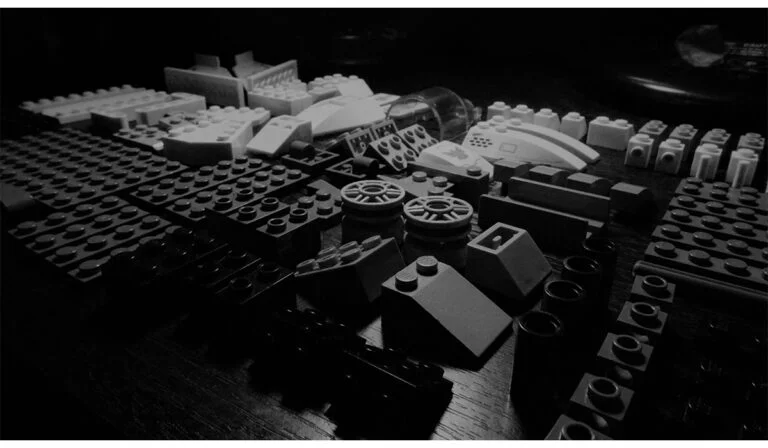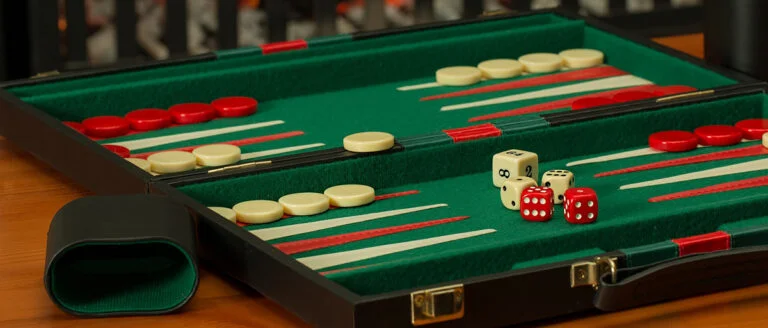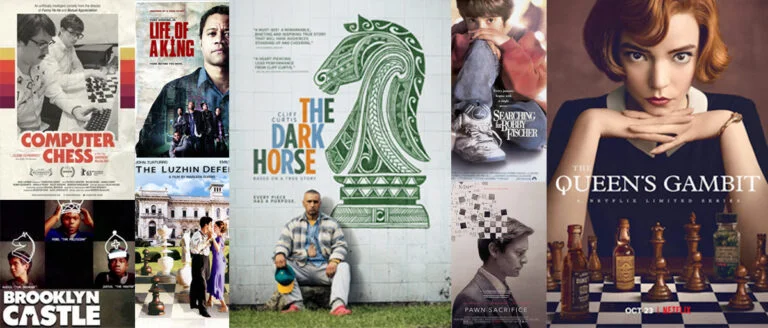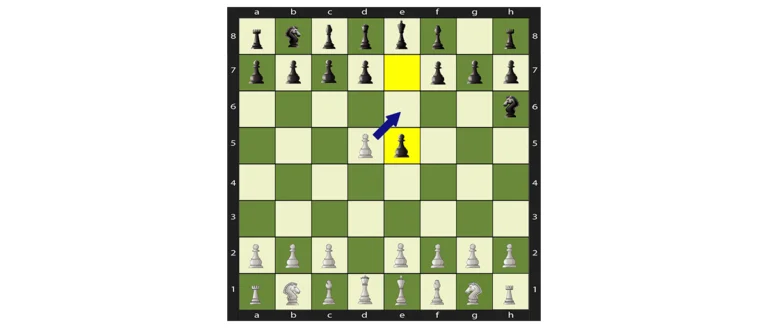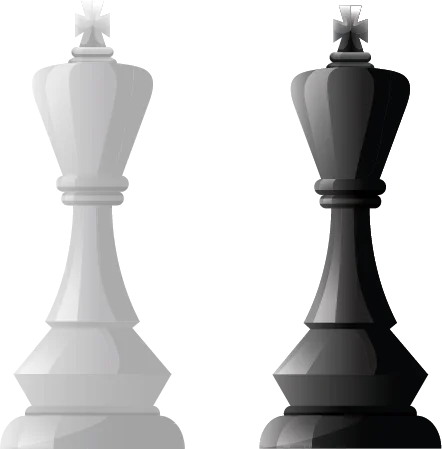
The king in chess, the heart and soul of the chessboard, is the most cherished and revered piece in the game. As the monarch of the realm, the king’s survival is the primary objective for both players. With a humble yet essential movement, the king can only move one square in any direction – horizontally, vertically, or diagonally. Let’s take a closer look at how exactly the king moves in chess and what makes him special.
The King in Chess: Positioning
The white king in chess always starts the game on the e1 square, while the black king starts on the e8 square:

How to Move the King in chess?
The King in chess can only move one square at a time. Either vertically, horizontally or diagonally. Here is an example of a king move in chess:

Though seemingly limited in its reach, the king’s significance lies in its inviolable role. The entire game revolves around protecting the king and ensuring its safety from threats and attacks. When all other pieces are lost, the king stands alone, representing the last line of defense in the battle.
The concept of check and checkmate revolves around the king’s vulnerability. When threatened with capture, the king faces a check, demanding immediate attention from the player to rectify the perilous situation. A checkmate, on the other hand, is the ultimate triumph when the enemy’s king is cornered with no escape, marking the end of the game.
Capturing the opponent’s king is not allowed in the standard rules of chess. The game ends when a player’s king is in checkmate, signaling the loss of the game. This rule emphasizes the symbolic significance of the king as the focal point of the game.
Despite its restricted movement, the king can take on a more active role in the endgame, participating in delicate maneuvers and contributing to pawn promotion. In a remarkable yet rare situation, the king can even play a role in forcing stalemate, salvaging a draw from the jaws of defeat.
As the central figure on the chessboard, the king symbolizes the essence of the game – the pursuit of victory and the quest for survival. Its value transcends material worth, as the loss of the king signifies the defeat of the kingdom. Adorned with the crown of utmost importance, the king embodies the heartwarming, intellectual, and strategic challenge of the noble game of chess.
Value of the King in Chess
Traditionally, we measure the value of a chess piece in the amounts of pawns they are worth. However, since the game is lost whenever the king is “captured” (i. e. checkmated), we don’t assign the king any particular value. Essentially the King is priceless.
Checking the King in Chess
An essential concept in chess is that of attacking the king, also known as “checking the king”. Basically, ‘check’ is a condition where the king is under threat of being captured in the opponent’s next move. As such, the player under threat needs to rectify this position in order to continue playing. When your king is checked, here are your options:
- Move the king piece: A check can be defended by simply moving the king to an adjacent square where he is not under any threat.
- Block the check: Moving a piece between the king and the attacking piece blocks the check and thus removes the threat…for now at least.
- Capture the checking piece: By capturing the attacking piece, the threat is averted.
If the check cannot be defended by any of these three options, then you are essentially checkmate, which means the game ends and opposing player wins.
Stalemate
Besides checkmate, there is another way a game of chess could end. If a player has no legal move but his king is not in check, the game is declared a stalemate, meaning this game ends in a draw. This is usually more common in the endgame, where one player may only have a king piece left on the board.
Castling the King in Chess
This is the only move which allows the king to move more than one square at a time. Castling is a move in which a player moves the king two squares towards a rook and the rook “jumps over” the king, placing it directly next to the king.
The King’s Gambit
The “King’s Gambit” is a famous and aggressive chess opening where a player sacrifices a pawn to open up lines for their pieces. It is named after the willingness of the player to “gamble” by exposing their king to potential danger.
The king’s historical evolution and symbolic importance in chess underscore the game’s origins in ancient strategy and warfare. Its unique role as both the primary target and the centerpiece of the game adds depth and significance to the quest for victory and survival on the chessboard. From its ancient roots to its pivotal role in the modern game, the king remains an enduring symbol of leadership, vulnerability, and strategic challenge in the noble game of chess.
Tips for Using the King in Chess
- Protect Your King Early; By Castling Together With The Rook
- Avoid Moving the Pawns in Front of Your King
- Use Your King more towards the endgame
King in Chess – Frequently Asked Questions
How Does the King Move in Chess?
The king in chess can move one square in any direction – vertically, horizontally or diagonally.
How Many Spaces Can the King Move in Chess?
The king in chess can only move one square at a time.
What Does A King Look Like In Chess?
The king is the tallest piece in chess. You can also identify the king by the cross on his head.
Can A King Take A Queen In Chess?
Yes, theoretically the king can take a queen in chess. That would however require a blunder by the opponent, as the king can’t approach the queen without putting himself into check (which would be an illegal move).
Can A King Still Castle After Its Been In Check?
Yes, the king can still castle after it has been in check. However, it is not allowed to castle while the king is in check or the king would be passing through a check.
Can a King Put a King in Check?
No, that is not possible. For a king to check another king, it would move itself into check, which is not allowed.
Why is the King in chess so Weak?
As in real-life, the king on its own is usually quite weak, commanding his army from the safety of a castle. But in chess the most probable reason why the king is comparatively weak, is the fact that it shouldn’t be too hard to checkmate.
Affiliate Disclosure
Some of the links on Chesspert.com are affiliate links. This means that we may earn a small commission if you click through and make a purchase, at no additional cost to you. Please note that our product reviews and roundups are independent, and the affiliate relationships do not influence our content in any way.
Chesspert.com is a participant in the Amazon Services LLC Associates Program, an affiliate advertising program designed to provide a means for sites to earn advertising fees by advertising and linking to Amazon.com.
Chesspert.com is also a participant in the GammonVillage Inc. Affiliate Program, an affiliate advertising program designed to provide a means for sites to earn advertising fees by advertising and linking to GammonVillage.com.
Amazon and the Amazon logo are trademarks of Amazon.com, Inc. or its affiliates. GammonVillage is a trademark of GammonVillage Inc. or its affiliates.
Our passion for board games extends far beyond the chess table. We’ll be your trusted companion, on a journey through the enchanting realms of not only chess but also backgammon, dominoes, mahjong, checkers, and a diverse array of other captivating board games.
Whether you’re in search of the ideal chess set, luxury backgammon sets, a chinese checkers set, a checkers set, or if you’re seeking the excitement of a thrilling game of mahjong solitaire, we’ll guide you along the way.
In partnership with our affiliates, we bring you an extensive selection of board games and past times to explore and enjoy.
Dive into our extensive collection of guides and reviews, and unlock the joy and exhilaration that board games offer. From exquisitely crafted game pieces to the essential accessories that elevate your gaming experience, we’re here to guide you through it all with ease and delight.
Join us in celebrating the timeless allure and camaraderie that these games nurture, one post at a time!

